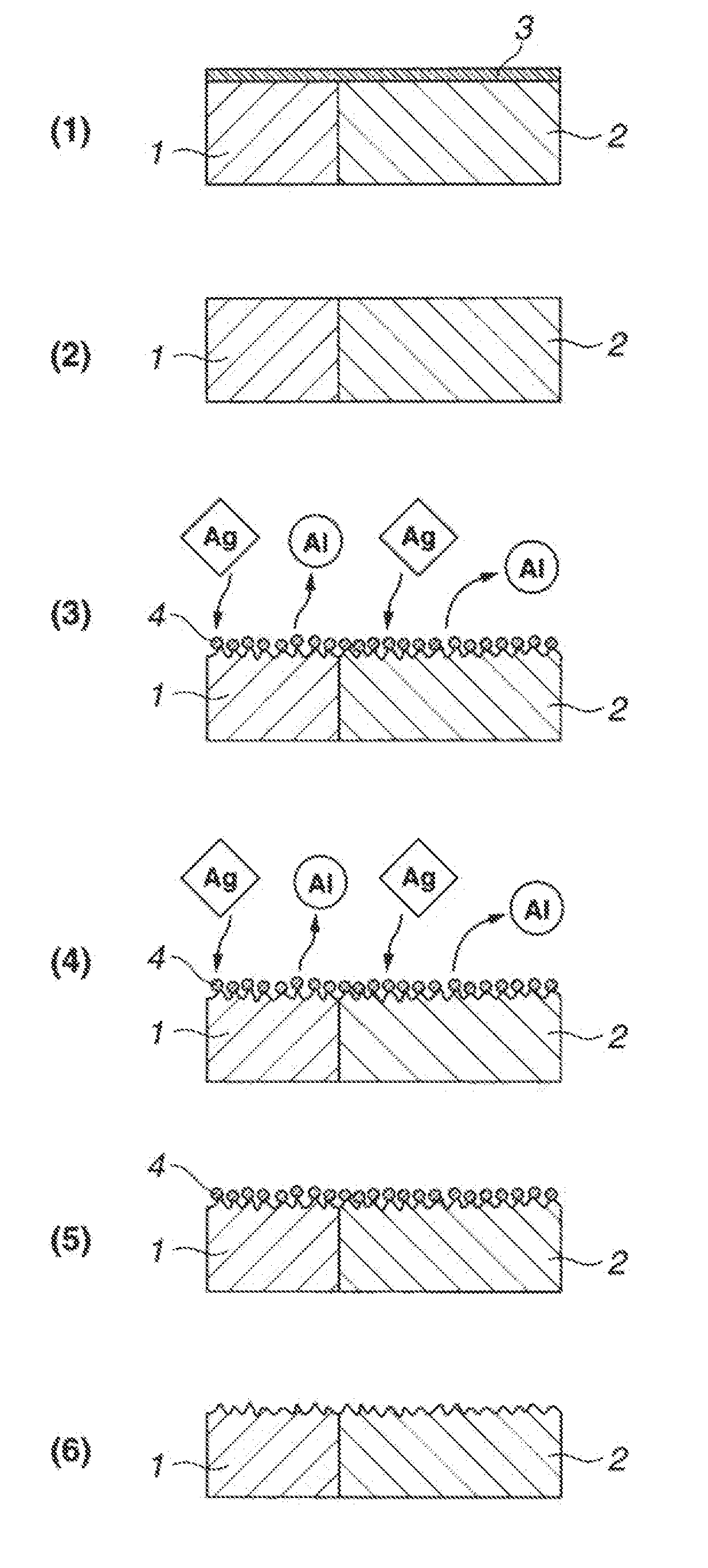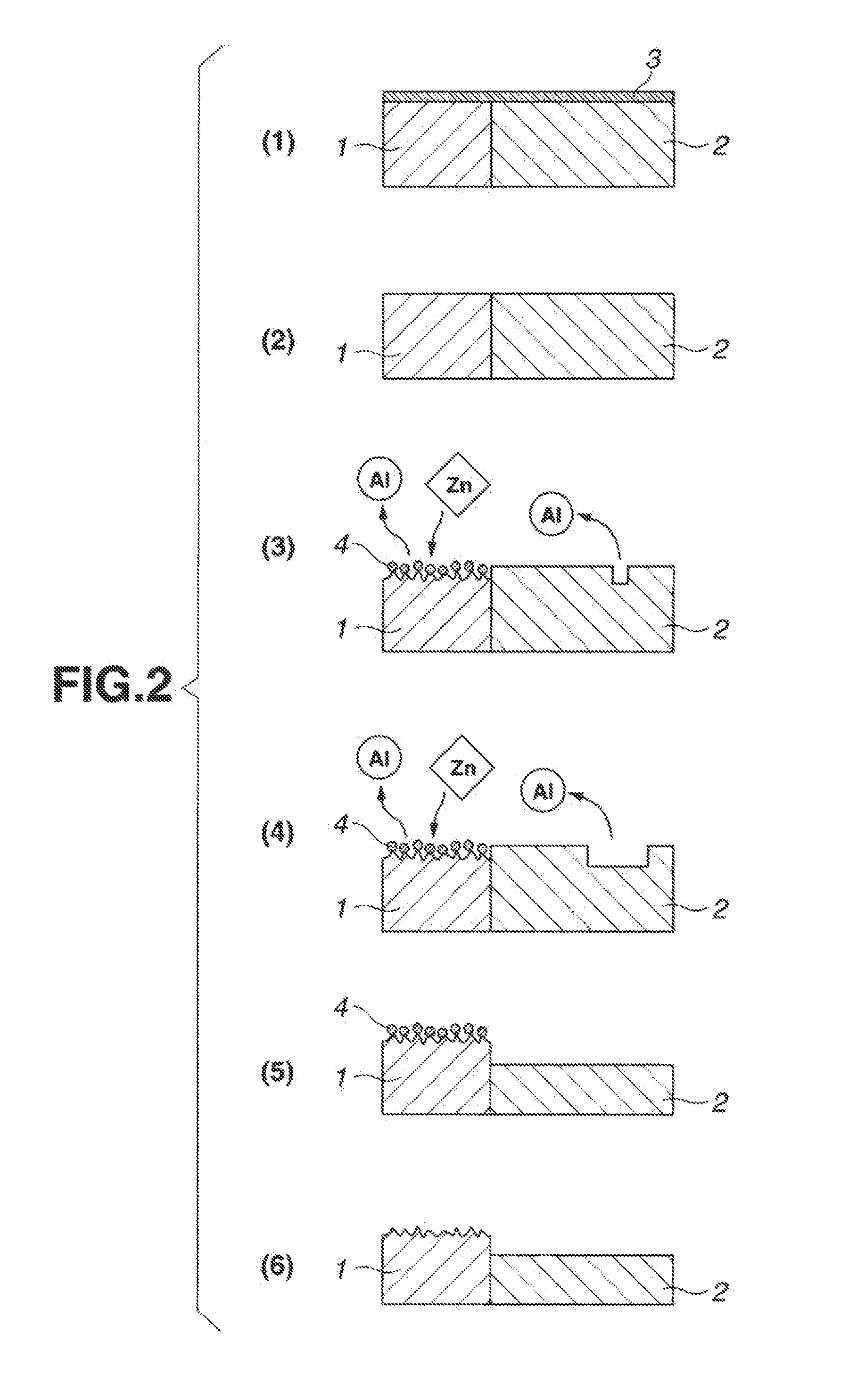Aluminum oxide film remover and method for surface treatment of aluminum or aluminum alloy
a technology of aluminum oxide film and remover, which is applied in the direction of liquid/solution decomposition chemical coating, coating, chemistry apparatus and processes, etc., can solve the problems of poor adhesion of the film formed in the subsequent steps, inability to meet the requirements of production, so as to achieve the effect of little corrosion
Active Publication Date: 2011-12-29
C UYEMURA & CO LTD +1
View PDF2 Cites 9 Cited by
- Summary
- Abstract
- Description
- Claims
- Application Information
AI Technical Summary
Benefits of technology
[0027]The present invention was completed to address the foregoing problems. An object of the present invention is to provide an aluminum oxide film remover and a method for surface treatment of aluminum or aluminum alloy using the remover. The remover according to the present invention is designed to be applied to an aluminum base material for uniform etching on any crystal orientation plane without only the specific orientation crystal plane (or the (100) plane) being etched. Etching in this method permits the subsequent process to form a uniform zinc-substituted film without a lack of zinc substitution.
[0029]More specifically, it has been found that when an aluminum oxide film is treated with a remover containing silver ions and / or copper ions, a solubilizing agent of the silver ions and / or copper ions, a quaternary ammonium hydroxide compound as an alkali and optionally a surfactant and / or zinc ions and having a pH value of 10 to 13.5, such a remover can rapidly remove the oxide film and to perform uniform etching on the aluminum ground having the specific crystal orientation plane without the aluminum ground being excessively etched and with the surface of aluminum or aluminum alloy being protected from corrosion. Thus, the present invention was completed.
[0048]In other words, the remover of the present invention, which contains silver ions and / or copper ions, can dissolve and remove rapidly and continuously the aluminum oxide film by wet process with minimum corrosion on the aluminum or aluminum alloy ground, and it can also achieve uniform etching on any aluminum material having a specific crystal orientation plane.Advantageous Effects of the Invention
[0050]Moreover, the remover according to the present invention contains silver ions and / or copper ions, so that it prepares an aluminum surface which can easily undergo zinc substitution in the subsequent zinc substitution step, thereby forming a compact zinc film. In addition, the remover according to the present invention additionally contains a quaternary ammonium hydroxide compound, which protects the aluminum ground from excessive etching. The remover of the present invention permits a good nickel plating film to be formed in the subsequent nickel plating process with only single zinc substitution treatment.
Problems solved by technology
However, if a strong aluminum oxide film remains on the surface after shaving or annealing, or if a specific crystal orientation plane exists on the aluminum surface, a plating film formed in subsequent steps will be poor in adhesion, or will be perforated.
However, this method still has room for improvement in terms of a complicated process, disadvantages in promptness and production costs.
Moreover, the method has a problem that the electrical insulation of the remaining oxide film leads to an increased thermal resistance, resulting in deterioration of electrical characteristics.
This practice is applicable only if the base is sufficiently thick but is inapplicable if the aluminum or aluminum alloy is as thin as 0.5 or 1.0 m, in which case the etching margin is limited.
These methods, however, involve difficulties in establishing adequate treatment conditions since the base material is inevitably etched excessively and where the base material is a thin film, the thin film may be disappeared or dissolved.
Moreover, a conventional grinding or mechanical polishing cannot be adopted for the thin film, unlike the case of die casting.
Hence, the oxide film formed by heat treatment in the fabricating process remains on the surface of the aluminum thin film, which worsens the problem.
That is to say, the reason of the severe corrosion of the base of aluminum or aluminum alloy when the conventional acid-based treating solution is applied to remove an aluminum oxide film is that there has been no effective method to deal with the difference between reactivity of aluminum oxide film with acid and reactivity of aluminum ground or aluminum alloy ground with acid.
Unfortunately, when the conventional alkaline remover is applied to the aluminum or aluminum alloy 2 having the (100) plane, substitution by the additive metal does not readily take place on its surface.
As the result, there is a problem that zinc substitution does not take place on the (100) plane in the subsequent process.
The result is that zinc substitution of aluminum does not take place on that crystal orientation plane in the subsequent processing, i.e., a lack of zinc substitution develops.
The lack of zinc substitution causes the subsequent nickel plating to give defective nickel film, which is poor in adhesion and which is partly perforated.
Such a defective nickel film is detrimental to electrical conductivity and appearance.
Method used
the structure of the environmentally friendly knitted fabric provided by the present invention; figure 2 Flow chart of the yarn wrapping machine for environmentally friendly knitted fabrics and storage devices; image 3 Is the parameter map of the yarn covering machine
View moreImage
Smart Image Click on the blue labels to locate them in the text.
Smart ImageViewing Examples
Examples
Experimental program
Comparison scheme
Effect test
examples
[0087]The present invention will be described below in more detail with reference to the following Examples and Comparative Examples, which are not intended to restrict the scope thereof.
the structure of the environmentally friendly knitted fabric provided by the present invention; figure 2 Flow chart of the yarn wrapping machine for environmentally friendly knitted fabrics and storage devices; image 3 Is the parameter map of the yarn covering machine
Login to View More PUM
| Property | Measurement | Unit |
|---|---|---|
| thick | aaaaa | aaaaa |
| thick | aaaaa | aaaaa |
| concentration | aaaaa | aaaaa |
Login to View More
Abstract
Disclosed herein is an aluminum oxide film remover for removing an oxide film on the surface of aluminum or aluminum alloy, which comprises silver ions and / or copper ions, a solubilizing agent for silver ions and / or copper ions, and a quaternary ammonium hydroxide compound, and has a pH value of 10 to 13.5. A method for surface treatment of aluminum or aluminum alloy is also disclosed, which comprises immersing a workpiece having aluminum or aluminum alloy at least on the surface thereof in the aluminum oxide film remover, and depositing the silver and / or copper contained in the remover on the surface of aluminum or aluminum alloy while removing the aluminum oxide film.
Description
CROSS-REFERENCE TO RELATED APPLICATION[0001]This non-provisional application claims priority under 35 U.S.C. §119(a) on Patent Application Nos. 2010-142787 and 2011-106928 filed in Japan on Jun. 23, 2010 and May 12, 2011, respectively, the entire contents of which are hereby incorporated by reference.TECHNICAL FIELD[0002]The present invention relates to an aluminum oxide film remover and a method for surface treatment of aluminum or aluminum alloy. More particularly, the present invention relates to an aluminum oxide film remover which is effective for a pretreatment employed to form UBM (under bump metal) or bumps on the wafer by plating, and it also relates to a method for surface treatment of aluminum or aluminum alloy.BACKGROUND ART[0003]There have previously been employed several methods for forming UBM or bumps on the silicon wafer. They include one which comprises performing a zinc substitution treatment to form a zinc film on an aluminum thin film electrode patterned on a wa...
Claims
the structure of the environmentally friendly knitted fabric provided by the present invention; figure 2 Flow chart of the yarn wrapping machine for environmentally friendly knitted fabrics and storage devices; image 3 Is the parameter map of the yarn covering machine
Login to View More Application Information
Patent Timeline
 Login to View More
Login to View More Patent Type & Authority Applications(United States)
IPC IPC(8): C23F1/00C09K13/00
CPCC23C18/1601C23C18/1635C23C18/1651C25D5/44C23C18/1824C23C18/54C23G1/22C23C18/18
Inventor SHIBATA, TOSHIAKIII, YOSHIHITOINAGAWA, HIROMU
Owner C UYEMURA & CO LTD
Features
- R&D
- Intellectual Property
- Life Sciences
- Materials
- Tech Scout
Why Patsnap Eureka
- Unparalleled Data Quality
- Higher Quality Content
- 60% Fewer Hallucinations
Social media
Patsnap Eureka Blog
Learn More Browse by: Latest US Patents, China's latest patents, Technical Efficacy Thesaurus, Application Domain, Technology Topic, Popular Technical Reports.
© 2025 PatSnap. All rights reserved.Legal|Privacy policy|Modern Slavery Act Transparency Statement|Sitemap|About US| Contact US: help@patsnap.com



